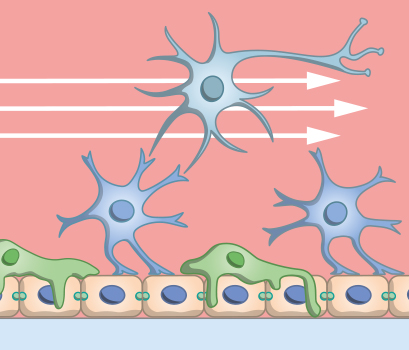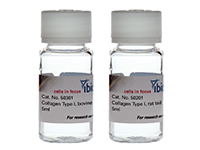Shear Stress and Barrier Function
Blood vessels in the central nervous system (CNS) and peripheral nervous system (PNS) are comprised of endothelial cells, which are subjected to constant fluid flow. This fluid flow generates shear stress, which significantly impacts the morphology, function, and behavior of these cells.
For example, shear stress can induce the production of reactive oxygen species (ROS) and the release of inflammatory cytokines in brain endothelial cells. This can lead to oxidative stress and inflammation, which have been implicated in the pathogenesis of neurological disorders such as stroke and Alzheimer's disease.
The blood-brain-barrier (BBB) is a highly selective and dynamic barrier that separates the brain from circulating blood. It plays a critical role in maintaining brain homeostasis and protecting the brain from harmful substances. Cell culture under flow assays can be used to model the BBB in vitro, which allows researchers to study the mechanisms of BBB function and dysfunction and to screen drugs that can penetrate the BBB.

Find Out MorePlease find more detailed information about the planning, conduction, and data analysis of cell culture under flow assays here. |
|
ibidi Solutions for Shear Stress Assays and Barrier Function
The ibidi Pump System is ideal for long-term cell culture under flow with defined shear stress values and is compatible with all µ-Slides with Luer adapters. It simulates defined continuous and pulsatile laminar flow and oscillatory flow to study cells in a more physiological environment. It is optimal for rolling and adhesion assays, transmigration, and invasion studies. Also, cells, spheroids, and organoids can be perfused for optimal nutrition. |
|
ibidi provides a variety of Channel Slides with different geometries. The µ-Slide I Luer family has one channel for standard flow experiments and rolling and adhesion assays. The µ-Slide VI has 6 channels and can be used for parallel flow assays. Both are available with the ibidi Polymer Coverslip and the ibidi Glass Coverslip, plus different heights and coatings. |
|
The μ-Slide I Luer 3D can help create an endothelial barrier without the need of an artificial filter membrane. Endothelial cells can be seeded on a suitable gel matrix, such as Collagen Type I. After connecting the slide to a pump and applying defined shear stress, an in vivo-like endothelial barrier is created, which is useful for rolling and adhesion assays). |
|
Endothelial cells can be seeded on a suitable gel matrix, such as Collagen Type I (bovine or rat tail origin). Find more information in AN 26: Collagen I Gel for 3D Cell Culture. |
|
The ibidi Stage Top Incubators provide physiological conditions for live cell imaging on every standard inverted microscope. They include CO2 and O2 control (e.g., for hypoxia experiments) as well as actively controlled humidity. They are available for single slides and dishes or for multiwell plates. |
|
Selected References
Cultivation of Brain Microvascular Endothelial Cells (BMECs) Under Flow
To investigate the effect of shear stress on gerbil brain microvascular endothelial cells (BMECs), cells were seeded into the µ-Slide I 0.6 Luer and subjected to unidirectional flow with the ibidi Pump System.
Gao JQ, Wang P, Yan JW, Ba LN, Shi PL, Wu HM, Guan XY, Cao YG, Sun HL, Mao XY. Shear Stress Rescued the Neuronal Impairment Induced by Global Cerebral Ischemia Reperfusion via Activating PECAM-1-eNOS-NO Pathway. Front Cell Dev Biol. 2021 Jan 21;8:631286. doi: 10.3389/fcell.2020.631286.
Read article
Cultivation of Astrocytes Under Flow
Astrocytes were incubated at physiological conditions using the ibidi Stage Top Incubator and exposed to shear stress using the ibidi Pump System.
Wakida NM, Cruz GMS, Pouladian P, Berns MW, Preece D. Fluid Shear Stress Enhances the Phagocytic Response of Astrocytes. Front Bioeng Biotechnol. 2020 Nov 11;8:596577. doi: 10.3389/fbioe.2020.596577.
Read article
in vitro Blood Brain Barrier (BBB) Model
Assembly of a blood brain barrier (BBB) in vitro system using the ibidi Pump System to check nanoparticles (for treatment of glioblastoma multiforme) for their ability to cross the barrier.
Grillone A, Battaglini M, Moscato S, Mattii L, de Julián Fernández C, Scarpellini A, Giorgi M, Sinibaldi E, Ciofani G. Nutlin-loaded magnetic solid lipid nanoparticles for targeted glioblastoma treatment. Nanomedicine (Lond). 2019 Mar;14(6):727-752. doi: 10.2217/nnm-2018-0436.
Read article
Cell Culture Under Flow of Brain Microvascular Endothelial Cells (BMECs)
Cultivation of BMECs under flow using the µ-Slide I 0.6 Luer and the ibidi Pump system to investigate the effect of shear stress.
Gao JQ, Wang P, Yan JW, Ba LN, Shi PL, Wu HM, Guan XY, Cao YG, Sun HL, Mao XY. Shear Stress Rescued the Neuronal Impairment Induced by Global Cerebral Ischemia Reperfusion via Activating PECAM-1-eNOS-NO Pathway. Front Cell Dev Biol. 2021 Jan 21;8:631286. doi: 10.3389/fcell.2020.631286.
Read article
Shear Stress Model to Study BBB Permeability
Establishing a shear stress model using human cerebral microvascular endothelial cells (hCMEC) and the ibidi Pump System to investigate drug permeability of the BBB.
Choublier N, Müller Y, Gomez Baisac L, Laedermann J, de Rham C, Declèves X, Roux A. Blood–Brain Barrier Dynamic Device with Uniform Shear Stress Distribution for Microscopy and Permeability Measurements. Applied Sciences 2021 Jun 16;11(12), 5584. doi: 10.3390/app11125584.
Read Article
Read on and learn more about Neuronal Function and Activity, Vascularization / Angiogenesis, and Neural Migration and Chemotaxis.








